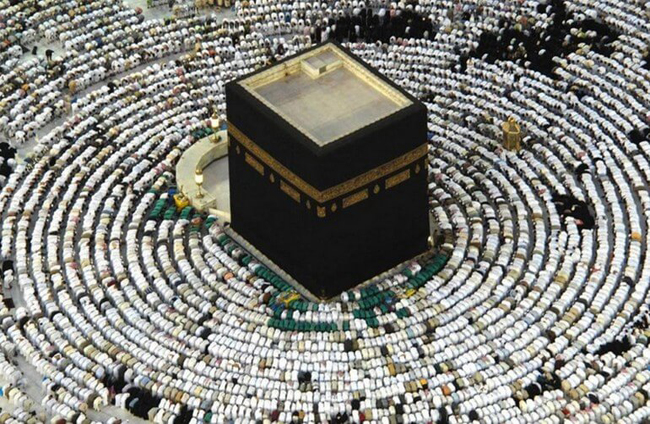-

 Know, the true nature of your Beloved.
Know, the true nature of your Beloved.
In His loving eyes, your every thought,
Word and movement is always –
Always Beautiful.
~ Hafiz

The Kabah
The Kabah is the focal point of the Muslim world, to which every Muslim in the world faces when praying to God. The Arabic word Kabah means ‘square’, ‘cube’, ‘high’ or ‘something that stands out’. It is also known as the Sacred House, the House of God or the House of High Standing.
One of the Five Pillars of Islam is to make Hajj, or Pilgrimage to Mecca, where the pilgrim on several occassions circumambulates seven times around the Kabah as a pre-requisite to completing their Hajj. Muslims can also perform the Umrah, or small Pilgrimage, where they again circumambulate around the Kabah.
Just as the Kabah is regarded as God’s House on Earth, there is a corresponding place above the Kabah in the Heavens called the Baytul Mamoor that holds a similar status and associated reverence. This has been explained by Hadrat Ali and Hadrat Abdullah bin Abbas, who both confirmed that this is the meaning of verse four of Surat Toor. Each day seventy thousand Angels circle the Baytul Mamoor and pray there, but unlike us on Earth, they are only allowed to make this pilgrimage once.
The Builders of the Kabah have been The Angels, Adam and then Abraham and Ishmael. After them the Kaba was rebuilt eight times. The internal dimensions are 10.5m wide x 8.2m wide, with an overall height of 14m. The walls are made from stones sourced from five different mountains.
The Hajar Aswad, the Black Stone, is built into one of the corners of the Kabah. The Black Stone has always been considered sacred throughout history, which was reaffirmed by the Prophet Muhammad, peace and blessings upon him, who used to greet and kiss this Stone. The Prophet said that, “The Hajar Aswad came from Paradise and was whiter than milk. It is the sins of mankind that has blackened it.” The Stone was originally placed into position by the Prophet Abraham and later relocated into this same position by Muhammad, peace and blessings be upon him, before he was given Prophethood.
Seyyed Hossein Nasr states, “Architecture is of course the par excellence of ordering space, and all sacred architecture achieves its basic goal of placing man in the presence of the Divine through the sacralization of the space which it forms, orders, and orients by means of various architectural techniques. The most primordial sacred architecture of Islam is the Kabah, the point where the Heavenly axis pierces the earth. This primordial temple built according to the Islamic tradition by Adam himself and then rebuilt by Abraham is the earthly reflection of that celestial temple which is also reflected in the heart of man. The harmony of dimensions, stability and symmetry of the Kabah, the centre of the Islamic cosmos, are to be found in the sacred architecture of the whole of the Islamic world.”
There is a concept of ‘Squaring the Circle’ in Sacred Geometry. In his book, ‘Sacred Geometry’, Robert Lawler explains, “The circumambulation of the Kabah at Mecca is a symbolic ritual related to the concept of the Squaring of the Circle. In Sacred Geometry, this is a practice which seeks to construct a square which is virtually equal in perimeter to the circumference of a given circle, or which is virtually equal in area to the area of a given circle. Nevertheless the Squaring of the Circle is of great importance to the geometer-cosmologist because for him the circle represents pure, unmanifest spirit-space, while the square represents the manifest and comprehensible world. When a near equality is drawn between the circle and square, the infinite is able to express its dimensions or qualities through the finite.”

